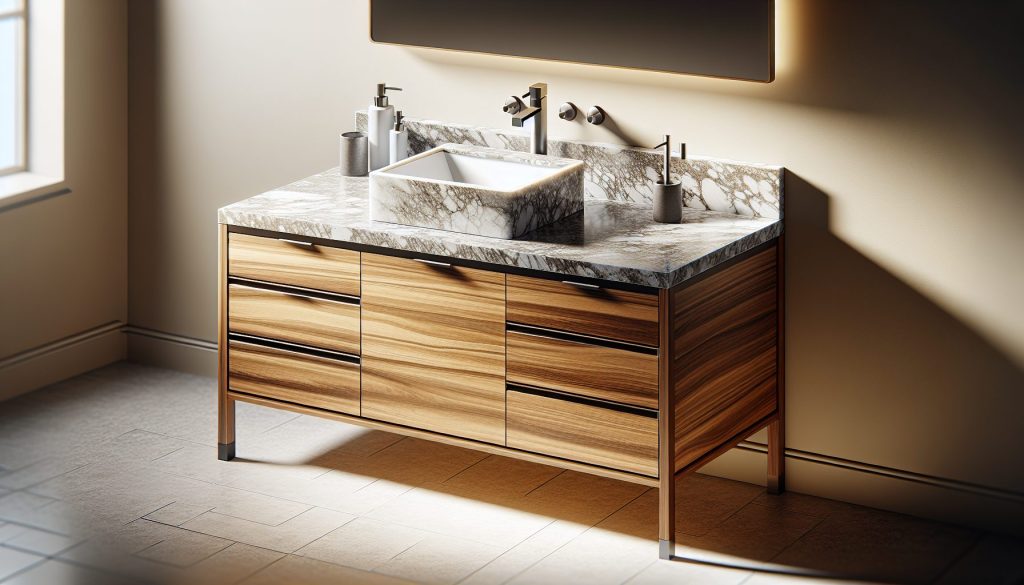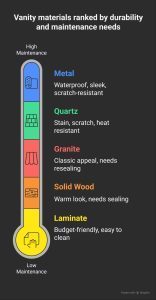
If you are asking yourself what is the most durable material for a bathroom vanity, you are not alone. In a 2020 Consumer Reports test, quartz consistently ranked as one of the hardest and most stain-resistant options, making it a favorite among many homeowners. Yet, the most suitable choice depends on your space, budget, and how much wear and tear your vanity sees each day.
Understand why durability matters
Your bathroom vanity faces humidity, water splashes, temperature changes, and frequent daily use. If it is built with a durable material, you can rely on it to resist warping, scratching, or staining over time. That means fewer repairs and fewer headaches. A sturdy vanity also boosts your home’s long-term value. When you invest in something that holds up under moisture and routine cleaning, you can enjoy a bathroom retreat that stays beautiful down the road.
Compare common vanity materials
Each material has pros and cons. Knowing these details will help you strike the right balance of style, strength, and cost.
Quartz
- Durability level: Very high
- Why it works: Quartz is engineered from natural stone and resins, creating a non-porous top that resists stains, scratches, and heat.
- Maintenance tip: Simple wipe-downs with mild detergent keep it gleaming, with no need for sealing.
- Considerations: Often costs more per square foot than granite, but it offers an upscale look and proven longevity.
Granite
- Durability level: High (needs sealing)
- Why it works: Granite’s classic appeal makes it a go-to for many homeowners who love natural stone.
- Maintenance tip: Resealing once or twice a year is key to prevent bacteria buildup and moisture damage.
- Considerations: Granite starts around $50 per square foot, which is often less expensive than quartz.
Solid wood and plywood
- Durability level: High to moderate
- Why it works: Solid wood (like oak or maple) looks warm and can last for decades when properly sealed. Plywood resists warping more than MDF, so it suits high-humidity bathrooms.
- Maintenance tip: Watch for moisture. Without adequate sealing, solid wood can absorb water or expand in heat.
- Considerations: If you want extra strength, look for dovetail or mortise-and-tenon joints. These craftsmanship details can extend the vanity’s lifespan.
Laminate and metal
- Durability level: Moderate to very high
- Why it works: Laminate is budget-friendly, easy to clean, and resists many stains. Metal vanities, often made from stainless steel, are waterproof, sleek, and highly scratch-resistant.
- Maintenance tip: For laminate, wipe gently to avoid scratches. For metal, use mild soap and keep an eye out for any rust spots.
- Considerations: Metal styles fit well with contemporary or industrial designs but may cost more than laminate.
Below is a quick table summarizing key points:
| Material | Durability | Moisture resistance | Maintenance | Approx. cost |
|---|---|---|---|---|
| Quartz | Very high | Excellent | Mild detergent wipe | Higher investment |
| Granite | High if sealed | Good with sealing | Reseal yearly | Moderate to high |
| Solid Wood | High but variable | Moderate | Keep sealed, wipe spills | Moderate |
| Plywood | Strong | Above average | Occasional cleaning | Moderate |
| Laminate | Adequate | Resistant, can lift | Gentle wiping, avoid heat | Budget-friendly |
| Metal | Very high | Excellent | Mild soap, check for rust | Higher cost |
Maintain it for longevity
Choosing a sturdy material is half the battle. Good news is, routine care can make your chosen vanity last even longer:
- Use soft, non-abrasive cloths or sponges.
- Clean up spills quickly, especially in high-traffic bathrooms.
- Avoid harsh chemicals that can damage protective sealants.
- Follow manufacturer recommendations or your contractor’s advice on sealing or refinishing schedules.
When you manage cleanup consistently, you reduce the risk of permanent stains or cracks that shorten your vanity’s life.
Pick your final option
Your choice of material depends on how you want your bathroom to feel and function for years to come. If you want an all-in-one solution with minimal upkeep, quartz stands out. If you love the charm of natural stone and do not mind reapplying sealant, granite offers a timeless statement. For a budget option, laminate can mimic the look of stone at a fraction of the cost. If cost is a key concern, you can learn about what is a good price for a bathroom vanity?.
If you are still exploring the best wood-related solutions, check out what is the best material to build a bathroom vanity from?. And if you want a deeper dive into overall construction quality, including joinery and hardware, you might look into what makes a bathroom vanity high quality?.
In the end, selecting the right bathroom vanity material is about balancing everyday practicality with style. You deserve a space that stands up to daily use and still wows guests. You have the data and the details, so you can make a confident choice for your next bathroom makeover.









